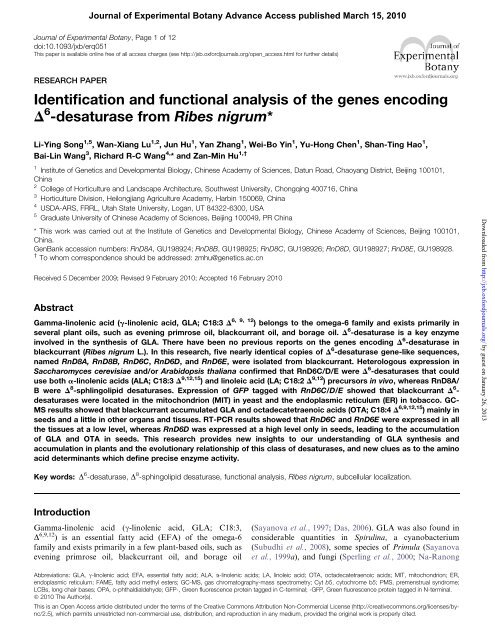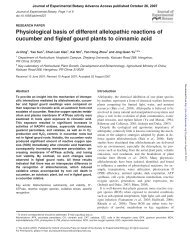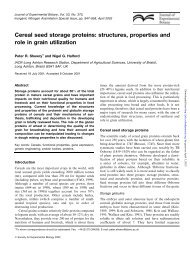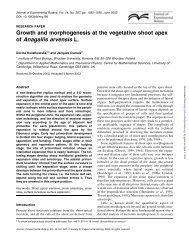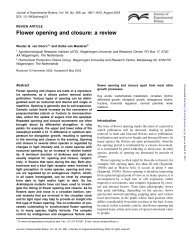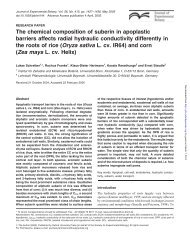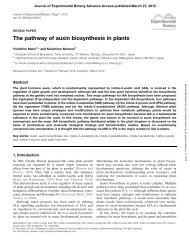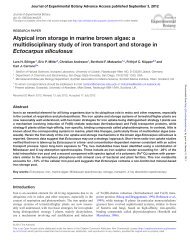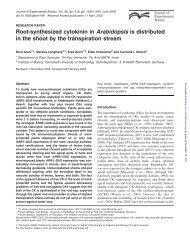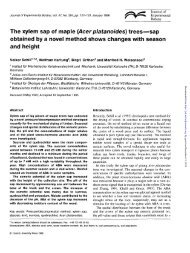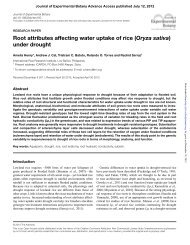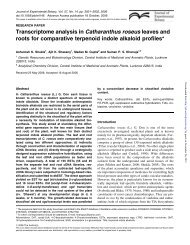desaturase from Ribes nigrum - Journal of Experimental Botany
desaturase from Ribes nigrum - Journal of Experimental Botany
desaturase from Ribes nigrum - Journal of Experimental Botany
You also want an ePaper? Increase the reach of your titles
YUMPU automatically turns print PDFs into web optimized ePapers that Google loves.
<strong>Journal</strong> <strong>of</strong> <strong>Experimental</strong> <strong>Botany</strong>, Page 1 <strong>of</strong> 12<br />
doi:10.1093/jxb/erq051<br />
This paper is available online free <strong>of</strong> all access charges (see http://jxb.oxfordjournals.org/open_access.html for further details)<br />
RESEARCH PAPER<br />
Identification and functional analysis <strong>of</strong> the genes encoding<br />
D 6 -<strong>desaturase</strong> <strong>from</strong> <strong>Ribes</strong> <strong>nigrum</strong>*<br />
Li-Ying Song 1,5 , Wan-Xiang Lu 1,2 , Jun Hu 1 , Yan Zhang 1 , Wei-Bo Yin 1 , Yu-Hong Chen 1 , Shan-Ting Hao 1 ,<br />
Bai-Lin Wang 3 , Richard R-C Wang 4, * and Zan-Min Hu 1,†<br />
1<br />
Institute <strong>of</strong> Genetics and Developmental Biology, Chinese Academy <strong>of</strong> Sciences, Datun Road, Chaoyang District, Beijing 100101,<br />
China<br />
2<br />
College <strong>of</strong> Horticulture and Landscape Architecture, Southwest University, Chongqing 400716, China<br />
3<br />
Horticulture Division, Heilongjiang Agriculture Academy, Harbin 150069, China<br />
4<br />
USDA-ARS, FRRL, Utah State University, Logan, UT 84322-6300, USA<br />
5<br />
Graduate University <strong>of</strong> Chinese Academy <strong>of</strong> Sciences, Beijing 100049, PR China<br />
* This work was carried out at the Institute <strong>of</strong> Genetics and Developmental Biology, Chinese Academy <strong>of</strong> Sciences, Beijing 100101,<br />
China.<br />
GenBank accession numbers: RnD8A, GU198924; RnD8B, GU198925; RnD8C, GU198926; RnD8D, GU198927; RnD8E, GU198928.<br />
y To whom correspondence should be addressed: zmhu@genetics.ac.cn<br />
Received 5 December 2009; Revised 9 February 2010; Accepted 16 February 2010<br />
Abstract<br />
<strong>Journal</strong> <strong>of</strong> <strong>Experimental</strong> <strong>Botany</strong> Advance Access published March 15, 2010<br />
Gamma-linolenic acid (g-linolenic acid, GLA; C18:3 D 6, 9, 12 ) belongs to the omega-6 family and exists primarily in<br />
several plant oils, such as evening primrose oil, blackcurrant oil, and borage oil. D 6 -<strong>desaturase</strong> is a key enzyme<br />
involved in the synthesis <strong>of</strong> GLA. There have been no previous reports on the genes encoding D 6 -<strong>desaturase</strong> in<br />
blackcurrant (<strong>Ribes</strong> <strong>nigrum</strong> L.). In this research, five nearly identical copies <strong>of</strong> D 6 -<strong>desaturase</strong> gene-like sequences,<br />
named RnD8A, RnD8B, RnD6C, RnD6D, and RnD6E, were isolated <strong>from</strong> blackcurrant. Heterologous expression in<br />
Saccharomyces cerevisiae and/or Arabidopsis thaliana confirmed that RnD6C/D/E were D 6 -<strong>desaturase</strong>s that could<br />
use both a-linolenic acids (ALA; C18:3 D 9,12,15 ) and linoleic acid (LA; C18:2 D 9,12 ) precursors in vivo, whereas RnD8A/<br />
B were D 8 -sphlingolipid <strong>desaturase</strong>s. Expression <strong>of</strong> GFP tagged with RnD6C/D/E showed that blackcurrant D 6 -<br />
<strong>desaturase</strong>s were located in the mitochondrion (MIT) in yeast and the endoplasmic reticulum (ER) in tobacco. GC-<br />
MS results showed that blackcurrant accumulated GLA and octadecatetraenoic acids (OTA; C18:4 D 6,9,12,15 ) mainly in<br />
seeds and a little in other organs and tissues. RT-PCR results showed that RnD6C and RnD6E were expressed in all<br />
the tissues at a low level, whereas RnD6D was expressed at a high level only in seeds, leading to the accumulation<br />
<strong>of</strong> GLA and OTA in seeds. This research provides new insights to our understanding <strong>of</strong> GLA synthesis and<br />
accumulation in plants and the evolutionary relationship <strong>of</strong> this class <strong>of</strong> <strong>desaturase</strong>s, and new clues as to the amino<br />
acid determinants which define precise enzyme activity.<br />
Key words: D 6 -<strong>desaturase</strong>, D 8 -sphingolipid <strong>desaturase</strong>, functional analysis, <strong>Ribes</strong> <strong>nigrum</strong>, subcellular localization.<br />
Introduction<br />
Gamma-linolenic acid (c-linolenic acid, GLA; C18:3,<br />
D 6,9,12 ) is an essential fatty acid (EFA) <strong>of</strong> the omega-6<br />
family and exists primarily in a few plant-based oils, such as<br />
evening primrose oil, blackcurrant oil, and borage oil<br />
(Sayanova et al., 1997; Das, 2006). GLA was also found in<br />
considerable quantities in Spirulina, a cyanobacterium<br />
(Subudhi et al., 2008), some species <strong>of</strong> Primula (Sayanova<br />
et al., 1999a), and fungi (Sperling et al., 2000; Na-Ranong<br />
Abbreviations: GLA, c-linolenic acid; EFA, essential fatty acid; ALA, a-linolenic acids; LA, linoleic acid; OTA, octadecatetraenoic acids; MIT, mitochondrion; ER,<br />
endoplasmic reticulum; FAME, fatty acid methyl esters; GC-MS, gas chromatography-mass spectrometry; Cyt b5, cytochrome b5; PMS, premenstrual syndrome;<br />
LCBs, long chair bases; OPA, o-phthaldialdehyde; GFP-, Green fluorescence protein tagged in C-terminal; -GFP, Green fluorescence protein tagged in N-terminal.<br />
ª 2010 The Author(s).<br />
This is an Open Access article distributed under the terms <strong>of</strong> the Creative Commons Attribution Non-Commercial License (http://creativecommons.org/licenses/bync/2.5),<br />
which permits unrestricted non-commercial use, distribution, and reproduction in any medium, provided the original work is properly cited.<br />
Downloaded <strong>from</strong><br />
http://jxb.oxfordjournals.org/ by guest on January 26, 2013
2<strong>of</strong>12 | Song et al.<br />
et al., 2005). However, there is no GLA in the major oil<br />
crops (Reddy and Thomas, 1996; Sayanova et al., 1999b),<br />
such as oilseed rape, soybean, peanut, and palm. GLA may<br />
be helpful in the prevention and/or treatment <strong>of</strong> diabetes,<br />
eye disease, osteoporosis, premenstrual syndrome (PMS),<br />
eczema, allergies, rheumatoid arthritis, high blood pressure,<br />
and heart disease (Horrobin, 1992).<br />
D 6 -<strong>desaturase</strong> is classified as an acyl-lipid <strong>desaturase</strong> that<br />
introduces a double bond between the pre-existing double<br />
bond and the carboxyl (front) end <strong>of</strong> the fatty acid (Qi<br />
et al., 2004). It is critical for the metabolic conversion <strong>of</strong><br />
linoleic acid (LA; C18:2 D 9,12 ) and a-linolenic acids (ALA;<br />
C18:3 D 9,12,15 ) into GLA and octadecatetraenoic acids<br />
(OTA; C18:4 D 6,9,12,15 ), respectively (Horrobin, 1992;<br />
Reddy and Thomas, 1996). The cytochrome b5 (Cyt b5)<br />
domain is essential for the borage D 6 -<strong>desaturase</strong> (Sayanova<br />
et al., 1999b), and three conserved His boxes <strong>of</strong> the enzyme<br />
are also proved to be essential for its function (Sayanova<br />
et al., 2001).<br />
In the last 20 years, a number <strong>of</strong> D 6 -<strong>desaturase</strong> genes,<br />
<strong>from</strong> cyanobacterium (Reddy et al., 1993), fungi (Sakuradani<br />
and Shimizu, 2003), plants (Sayanova et al., 1997, 1999a;<br />
Sperling et al., 2000; Whitney et al., 2003), and animals<br />
(Napier et al., 1998; Seiliez et al., 2001), were isolated and<br />
characterized. Accumulation, function, and expression <strong>of</strong><br />
D 6 -<strong>desaturase</strong> genes had been investigated in only a few<br />
higher plants synthesizing GLA. In Borago <strong>of</strong>ficinalis,<br />
GLA is accumulated up to 23.1% <strong>of</strong> the total fatty acids in<br />
mature seeds, and more than 8.0% in other tissues. The<br />
D 6 -<strong>desaturase</strong> gene is expressed but at different levels in all<br />
tissues: higher in seeds, young leaves, and roots, and lower in<br />
mature leaves and flowers (Sayanova et al., 1999c). In<br />
Anemone leveillei, GLA and OTA are absent in seeds, but<br />
are readily detectable in leaves. The D 6 -<strong>desaturase</strong> gene is<br />
expressed at the highest level in leaves, a moderate level in<br />
seeds, and is completely absent in roots (Whitney et al.,<br />
2003). In Primula, different species accumulated varying<br />
levels <strong>of</strong> GLA and OTA. In the species with a high level <strong>of</strong><br />
D 6 -fatty acids, GLA and OTA accumulated mainly in the<br />
leaves and seeds, and relatively little in roots (Sayanova<br />
et al., 1999a).<br />
It was recently reported that there were two nearly<br />
identical copies <strong>of</strong> the D 6 -<strong>desaturase</strong> gene, which differ by<br />
nine silent mutations, in the marine microalga Glossomastix<br />
chrysoplasta (Hsiao et al., 2007). While, in the higher plants<br />
that had been investigated, there were no instances <strong>of</strong><br />
several different active D 6 -<strong>desaturase</strong> genes being found in<br />
the same organism.<br />
D 6 -<strong>desaturase</strong>s <strong>from</strong> some organisms exhibited substrate<br />
selectivity. The D 6 -<strong>desaturase</strong> <strong>of</strong> moss (Ceratodon purpureus)<br />
preferred C16:1 D 9 over C18:1 D 9 (Sperling et al., 2000),<br />
whereas the D 6 -<strong>desaturase</strong> <strong>from</strong> Mucor rouxii had a strong<br />
preference for the C18:1 D 9 (Na-Ranong et al., 2005). In<br />
Boraginaceae, the D 6 -<strong>desaturase</strong> <strong>from</strong> Macaronesian<br />
Echium gentianoides preferred the LA substrate over the<br />
ALA substrate (García-Maroto et al., 2006). D 6 -<strong>desaturase</strong>s<br />
<strong>from</strong> different Primula species had different substrate<br />
preferences; for example, the D 6 -<strong>desaturase</strong> <strong>from</strong> Primula<br />
vialii had a very strong preference for ALA compared with<br />
LA (Sayanova et al., 2003), whereas that <strong>from</strong> Primula<br />
cortusoides mainly desaturated LA (Sayanova et al., 2006).<br />
The fatty acid-synthesizing and desaturation system had<br />
been widely known to exist in chloroplasts and the<br />
endoplasmic reticulum (ER) in higher plants. It had been<br />
confirmed by using the [ 14 C]linoleoyl phosphatidylcholine<br />
that the microsomal membrane, prepared <strong>from</strong> the developing<br />
cotyledons, contained an active D 6 -<strong>desaturase</strong>,<br />
which catalysed the conversion <strong>of</strong> linoleate into c-linolenate<br />
(Stymne and Stobart, 1986). Since then, front-end <strong>desaturase</strong>s<br />
were generally thought to locate in the ER (Napier<br />
et al., 1999). To date, however, there has been no direct<br />
evidence for subcellular localization to locate plant D 6 -<br />
<strong>desaturase</strong>s.<br />
Blackcurrant seed oil, typically containing 15–20% GLA,<br />
is known to be one <strong>of</strong> the available natural sources <strong>of</strong> GLA<br />
(Traifler et al., 1988). However, until now, the D 6 -<strong>desaturase</strong><br />
blackcurrant gene has not been reported.<br />
In this research, GLA was detected mainly in seeds<br />
and rarely in other organs <strong>of</strong> blackcurrant. Three genes<br />
were cloned (RnD6C, RnD6D, and RnD6E) encoding<br />
D 6 -<strong>desaturase</strong>s and two genes (RnD8A, RnD8B) encoding<br />
D 8 -sphingolipid <strong>desaturase</strong>s in blackcurrant. RnD6C,<br />
RnD6D, and RnD6E could use both LA and ALA as<br />
substrate. RnD6C/D/E was located in the mitochondrion<br />
(MIT) in yeast and the ER in tobacco. RnD6C and RnD6E<br />
were expressed in all the tissues at a low level, whereas<br />
RnD6D was expressed at a high level but only in seeds. This<br />
research should provide a useful addition to the previously<br />
identified orthologues <strong>from</strong> other plants and may well prove<br />
to be useful for biotechnological applications. Furthermore,<br />
this research may also provide not only new insights into<br />
the evolutionary relationship <strong>of</strong> this class <strong>of</strong> <strong>desaturase</strong>s but<br />
also some new clues as to the amino acid determinants<br />
which define the precise enzyme activity (i.e. either D 6 -<br />
<strong>desaturase</strong> or D 8 -sphingolipid <strong>desaturase</strong>).<br />
Materials and methods<br />
Plant materials<br />
Blackcurrant (<strong>Ribes</strong> <strong>nigrum</strong> L. var. BRÖDTORP), a Finnish<br />
variety (Wassenaar and H<strong>of</strong>man, 1966) was used in this research.<br />
Blackcurrant genomic DNA extraction and full-length<br />
D 6 -<strong>desaturase</strong> gene cloning<br />
Genomic DNA was extracted by a DNA extraction kit (Biomedtech,<br />
Beijing, China) <strong>from</strong> young leaves <strong>of</strong> blackcurrant. The DNA<br />
fragments <strong>of</strong> putative cytochrome b5 fusion <strong>desaturase</strong> genes were<br />
amplified <strong>from</strong> the genomic DNA by using degenerated primers<br />
designed according to the sequence <strong>of</strong> conserved histidine boxes <strong>of</strong><br />
known Cyt b5 fusion <strong>desaturase</strong>s (Reddy and Thomas, 1996;<br />
Whitney et al., 2003; Sayanova et al., 2003). The primer sequences<br />
were: PL, 5#-TTGGGTGAAAGACCATCCA(T)GGT(A)GG-3#<br />
PR, 5#-GGGAAACAAA(G)TGA(G)TGCTCAACCTG-3#. Five<br />
amplified products (about 1032 bp) were cloned into the pEASY-<br />
Blunt vector (TransGen Biotech, Beijing, China) and sequenced.<br />
The 5# and 3# extension <strong>of</strong> these fragments were obtained by the<br />
genomic walking method using the BD GenomeWalkerä Universal<br />
Kit (BD Biosciences, Palo Alto, CA, USA). Conserved genomic<br />
Downloaded <strong>from</strong><br />
http://jxb.oxfordjournals.org/ by guest on January 26, 2013
walking primers were: 5GSP1 (480), GACATTGTCTG(A/G)TA-<br />
ATGCCCAGAATC; 5GSP2 (270), CCTATAATCTTTGGATA-<br />
CATCTG(A/g)GA(C/t); 3GSP1(702), AGGAA(A/G)TTGGAGT-<br />
TTGATGCTTTTGCTAGGTTC; 3GSP2(1078), CG(T/C)CTTG-<br />
GATGGATTGGTTTCATGGTGG. The PCR products were<br />
cloned into the pEASY-Blunt vector (TransGen Biotech) and<br />
sequenced. Five sequences similar to ‘front-end’ D 6 -<strong>desaturase</strong> or<br />
D 8 -sphingolipid <strong>desaturase</strong> genes were obtained and named<br />
RnD8A, RnD8B, RnD6C, RnD6D, and RnD6E.<br />
Yeast expression plasmid construction and transformation<br />
The five sequences similar to ‘front-end’ D 6 -<strong>desaturase</strong> or D 8 -<br />
sphingolipid <strong>desaturase</strong> genes were purified <strong>from</strong> 1% agarose gel,<br />
digested with the restriction enzymes HindIII and SacI (the<br />
restriction sites <strong>of</strong> the enzymes had been designed in the primers),<br />
cloned into the corresponding sites <strong>of</strong> the yeast expression vector<br />
pYES2 (Invitrogen, UK), and sequenced. The five construct<br />
plasmids (pRnD8A, pRnD8B, pRnD6C, pRnD6D, and pRnD6E)<br />
were transformed into S. cerevisiae strain INV Sc 1 (Invitrogen) by<br />
using the lithium acetate method.<br />
Characterization <strong>of</strong> genes with a D 8 -sphingolipid <strong>desaturase</strong><br />
function in S. cerevisiae<br />
The RnD8A/B-transformed yeasts were grown in SC-U, containing<br />
1% raffinose and 1% (w/v) tergitol NP-40 (Sigma, Germany),<br />
and induced with 2% (w/v) galactose. The yeast cells were<br />
cultivated for an additional 72 h at 20 °C, and then harvested and<br />
dried at 50 °C. 100 mg dried cells were used to prepare the long<br />
chain bases (LCBs) <strong>from</strong> glycerolipids for subsequent analysis by<br />
HPLC as previously described (Markham et al., 2006) and<br />
phytosphinganine (t18:0) (Sigma) was used as the standard.<br />
Briefly, induced yeast cells (100 mg, dried weight) were grounded<br />
into a fine powder, and subjected to strong alkaline hydrolysis in<br />
2 ml <strong>of</strong> 10% (w/v) aqueous Ba(OH)2 and 2 ml <strong>of</strong> dioxane for 16 h<br />
at 110 °C. After hydrolysis, 2 ml <strong>of</strong> 2% (w/v) ammonium sulphate<br />
was added, and the liberated sphingolipid long chain bases were<br />
extracted with 2 ml <strong>of</strong> diethylether. The upper phase was removed<br />
to a second tube, dried under nitrogen, and derivatized with<br />
o-phthaldialdehyde (OPA) (Invitrogen) as previously described<br />
(Merrill et al., 2000). Individual LCBs were separated by reversed<br />
phase HPLC (Waters 600E, USA) using Penomenex C18 column<br />
(25034.6 mm, 5 lm). Elution was carried out at 1.5 ml min 1 with<br />
20% solvent RA (5 mM potassium phosphate, pH 7), 80% solvent<br />
RB (100% methanol) for 7 min, increasing to 90% solvent RB by<br />
15 min, returning to 80% solvent RB and re-equilibrating for 2 min<br />
(Markham et al., 2006). Fluorescence was excited at 340 nm and<br />
detected at 455 nm.<br />
Characterization <strong>of</strong> genes with D 6 -<strong>desaturase</strong> function in<br />
S. cerevisiae<br />
Heterologous expression <strong>of</strong> RnD6C/D/E was induced under<br />
transcriptional control <strong>of</strong> the yeast GAL1 promoter. Yeast cultures<br />
Table 1. Primers (<strong>from</strong> 5# to 3#) used in RT-PCR<br />
Primer name Sequences<br />
RTDL94 GGTAAGGTTTACAATGTCACCC<br />
RTDR830 CGCTTTGAGAGCAACATG<br />
RTA&BL420 ATG(C/T)(T/G)TTGTGGAGGCTTA<br />
RTA&BR1077 AGCATGAAATATCTATAGTCCCTT<br />
RTC&EL322 GAAAGGGCATGGTGTTTTC<br />
RTC&ER864 CAA(A/G)AGTCTGTTGGGTACTTTTTT<br />
Actin L CATCAGGAAGGACTTGTACGG<br />
Actin R GATGGACCTGACTCGTCATAC<br />
were grown to logarithmic phase at 30 °C in SC-U containing 1%<br />
(w/v) raffinose, 0.67% (w/v) yeast nitrogen and 0.1% (w/v) tergitol<br />
NP-40 (sigma), supplemented with 0.5 mM LA (Sigma). The cells<br />
were induced by the addition <strong>of</strong> 2% (w/v) galactose and cultivated<br />
for an additional 72 h at 20 °C. Subsequently, cells were harvested<br />
by centrifugation, and washed three times with sterile distilled<br />
water. The cells were dried and ground into a fine powder. Then<br />
the fatty acid analysis was performed using the following method.<br />
Plant plasmid construction and transformation <strong>of</strong> Arabidopsis<br />
thaliana<br />
RnD6C/D/E cDNA under the control <strong>of</strong> the duplicated CaMV 35S<br />
(D35S) promoter and nos terminator were constructed in the<br />
binary vector pGI0029 (John Innes Centre, UK). The inserts were<br />
sequenced to ensure that undesired mutations were not introduced<br />
during the PCR reactions. Agrobacterium tumefaciens strain<br />
LBA4404 containing the helper plasmid pSoup (John Innes<br />
Centre, UK) was used as the host <strong>of</strong> the pGI0029 vectors<br />
containing the D 6 -<strong>desaturase</strong> gene. Arabidopsis thaliana (ecotype<br />
Columbia) was used for plant transformation with the floral dip<br />
method (Clough and Bent, 1998). T1 seeds were plated out on<br />
selective media containing kanamycin (50 mg l 1 ), and then the<br />
selected transformed plants were transferred to soil. The harvested<br />
seeds were selected for another two generations, and the fixed<br />
transformants were selected.<br />
Fatty acid analysis<br />
Cellular fatty acid was extracted by incubating 50 mg yeast powder<br />
or 200 mg fresh leaves <strong>of</strong> transformed A. thaliana or different<br />
blackcurrant tissues (young root, young stem, leaves, flowers,<br />
ripening exocarp, and ripening seeds) in 3 ml <strong>of</strong> 7.5% (w/v) KOH in<br />
methanol for saponification at 70 °C for3h.AfterthepHwas<br />
adjusted to 2.0 with HCl, the fatty acid was subjected to methylesterification<br />
with 2 ml 14% (w/v) boron trifluoride in methanol at<br />
70 °C for 1.5 h. Then 1 ml <strong>of</strong> 0.9% (w/v) NaCl was added and mixed<br />
well. Subsequently, fatty acid methyl esters (FAME) were extracted<br />
with 2 ml hexane. The upper phase was removed to a second tube,<br />
dried under nitrogen and dissolved in acetic ether. Qualitative<br />
analysis <strong>of</strong> FAME was performed by GC-MS (gas chromatographymass<br />
spectrometry, TurboMass, PerkinElmer, USA) with the<br />
capillary column (BPX-70, 30 m30.25 mm30.25 lm). FAME were<br />
analysed and identified by the comparison <strong>of</strong> their peaks with those<br />
<strong>of</strong> standards: LA, ALA, and GLA (Sigma).<br />
Subcellular localization <strong>of</strong> D 6 -<strong>desaturase</strong> in yeast<br />
To determine its subcelluar location, RnD6C/D/E had been cloned<br />
in-frame at the 5’ end and 3’ end with the GFP gene in the pYES2<br />
Table 2. Fatty acid composition <strong>of</strong> different blackcurrant tissues<br />
The levels <strong>of</strong> individual fatty acids were determined by GC-MS and<br />
expressed as mole% <strong>of</strong> the total. Values given represent means 6SE<br />
obtained <strong>from</strong> three independent experiments.<br />
Young<br />
root<br />
Control <strong>of</strong> starch branching in barley | 3<strong>of</strong>12<br />
Young<br />
stem<br />
Leaf Flower Ripening<br />
exocarp<br />
Ripening<br />
seeds<br />
16:0 32.360.7 30.460.7 17.260.6 34.761.5 35.060.2 10.160.0<br />
16:1 23.460.9 – 1.760.0 – – –<br />
16:2 – – 1.260.0 – – –<br />
16:3 – – 5.060.2 – – –<br />
18:0 14.360.6 11.260.8 2.560.3 11.160.6 19.561.0 3.960.0<br />
18:1 6.560.2 2.960.3 1.760.1 9.960.5 4.660.3 12.660.2<br />
LA 16.760.3 30.861.2 10.760.4 24.661.3 22.260.8 42.760.1<br />
GLA 0.860.0 1.160.0 0.460.0 0.360.1 – 12.760.2<br />
ALA 3.660.0 20.760.5 57.161.3 16.961.2 16.760.7 13.460.1<br />
OTA 0.460.0 0.960.0 0.460.0 0.360.0 – 2.660.1<br />
Downloaded <strong>from</strong><br />
http://jxb.oxfordjournals.org/ by guest on January 26, 2013
4<strong>of</strong>12 | Song et al.<br />
Fig. 1. Alignment <strong>of</strong> deduced amino acid sequences <strong>of</strong> blackcurrant <strong>desaturase</strong>s (RnD6A, RnD6B, RnD6C, RnD6D, and RnD6E),<br />
borage D 6 -<strong>desaturase</strong> (acc. no. AAC49700), and D 8 -sphingolipid <strong>desaturase</strong> (AAG43277) by using DNAMAN 6.0. Numbers on the right<br />
denote the number <strong>of</strong> amino acid residues. Residues identical for all sequences in a given position are in white text on a black<br />
background, and those identical in two <strong>of</strong> the three or similar in the three sequences are on a grey background. Characteristic regions <strong>of</strong><br />
the N-terminal cyt b5 motif are underlined and the conserved His boxes are indicated by black dots.<br />
vector and expressed in the yeast strain INV Sc 1. Live yeast cells<br />
were incubated with MitoTracker Red and/or ER-tracker Blue as<br />
described in experimental protocol <strong>of</strong> ‘MitoTracker Ò and Mito-<br />
Fluorä Mitochondrion-Selective Probes’ and ‘ER-Trackerä Dyes<br />
for Live-Cell Endoplasmic Reticulum Labeling’ (Invitrogen). The<br />
localization <strong>of</strong> RnD6C/D/E-GFP was determined by using a fluorescence<br />
microscope (Olympus, Tokyo, Japan). The desaturation<br />
function <strong>of</strong> the fused proteins was identified by GC-MS.<br />
Subcellular localization <strong>of</strong> D 6 -<strong>desaturase</strong> in tobacco<br />
Wild-type Nicotiana benthamiana was grown as previously described<br />
(Ruiz et al., 1998; Voinnet et al., 1998). A. tumefaciens<br />
strain LBA4404 with plastids containing RnD6C/D/E-GFP or<br />
GFP-RnD6C/D/E and the strain carrying the p19 construct<br />
(Voinnet et al.., 2003) were grown at 28 °C in YEB supplemented<br />
with 50 mg l 1 kanamycin and 5 mg l 1 tetracycline to the<br />
stationary phase. Bacterial cells were precipitated by centrifugation<br />
Downloaded <strong>from</strong><br />
http://jxb.oxfordjournals.org/ by guest on January 26, 2013
at 5000 g for 15 min at room temperature and resuspended in 10<br />
mM MgCl2 and 150 mg l 1 acetosyringone. Cells were left in this<br />
medium for 3 h and then infiltrated into the abaxial air spaces <strong>of</strong><br />
2–4-week-old N. benthamiana plants. The culture <strong>of</strong> Agrobacterium<br />
was brought to an optical density <strong>of</strong> 1.0 (OD600) to avoid toxicity<br />
(Voinnet et al., 2000). Transient co-expression <strong>of</strong> the RnD6C/D/E-<br />
GFP or GFP-RnD6C/D/E and the mCherry-tagged ER marker<br />
(Nelson et al., 2007) and p19 constructs was at OD600 1.0<br />
(Voinnet et al., 2003). The localization <strong>of</strong> RnD6C/D/E tagged with<br />
GFP was determined under a confocal microscope (Leica TCS<br />
SP5, Leica Microsystems, Bensheim, Germany).<br />
Gene expression analysis<br />
Total RNA <strong>from</strong> different tissues was extracted using a RNA<br />
extraction kit (Biomed-tech, Beijing, China). cDNA was synthesized<br />
<strong>from</strong> total RNA using a reverse transcriptional kit (Toyobo,<br />
Osaka, Japan). The RT-PCR primers for detecting our cloned<br />
genes <strong>from</strong> blackcurrant were listed in Table 1. The housekeeping<br />
actin gene was used as the control in the RT-PCR reactions. The<br />
reaction was denatured at 95 °C for 3 min, followed by 30 cycles<br />
<strong>of</strong> 30 s at 95 °C, 30 s at 60 °C, 1 min at 72 °C, and then 7 min at<br />
72 °C.<br />
Cladistic analysis<br />
Nucleotide sequences <strong>of</strong> the <strong>desaturase</strong>s were aligned by using the<br />
program ClustalX 2.0.10 (Thompson et al., 1994) and manual<br />
adjustment. The phylogenetic tree was generated using the<br />
alignment output based on the Minimum evolution method<br />
(Rzhetsky and Nei, 1992), as implemented in the Mega 4.1 (Kumar<br />
et al., 2001). The complete deletion option and the Jukes and<br />
Cantor metric were used, and confidence <strong>of</strong> the tree branches was<br />
checked by bootstrap generated <strong>from</strong> 1000 replicates.<br />
Results<br />
Control <strong>of</strong> starch branching in barley | 5<strong>of</strong>12<br />
Fig. 2. GC analysis <strong>of</strong> FAME <strong>of</strong> total lipids <strong>of</strong> Saccharomyces cerevisiae. (A) The total fatty acid in yeast INV Sc 1; (B) the total fatty acid<br />
in yeast INV Sc 1 with LA and GLA standard (Sigma); (C) the total fatty acid in induced yeast transformed with pYES2; (D, E, F) the total<br />
fatty acid in induced yeast transformed with RnD6C/D/E (arrows indicated the novel peak <strong>of</strong> GLA). All the GC-MS an alyses were<br />
repeated three times and representative results are shown.<br />
Fatty acid composition in different blackcurrant tissues<br />
The fatty acid compositions <strong>from</strong> young roots and stems,<br />
flowers, mature leaves, ripening exocarp, and seeds <strong>of</strong><br />
blackcurrant were determined by GC-MS. The results<br />
showed that all the detected tissues except ripening exocarp<br />
contained GLA and OTA. There was very little GLA<br />
(2.6% <strong>of</strong> total fatty acid) in ripening seeds (Table 2).<br />
Isolation <strong>of</strong> putative D 6 -<strong>desaturase</strong> genes<br />
Using the genomic DNA walking method, five DNA<br />
sequences (1347 bp in length) were cloned and sequenced.<br />
Downloaded <strong>from</strong><br />
http://jxb.oxfordjournals.org/ by guest on January 26, 2013
6<strong>of</strong>12 | Song et al.<br />
Fig. 3. Formation <strong>of</strong> phytosphingenines in yeast cells by heterologous expression <strong>of</strong> a D 8 -sphingolipid <strong>desaturase</strong> <strong>from</strong> blackcurrant. (A)<br />
The phytosphinganine (t18:0) (Sigma) as the standard. (B) The predominating LCBs <strong>from</strong> Saccharomyces cerevisiae cells (INV Sc 1) as<br />
the control harbouring the empty vector pYES2 is phytosphinganine (t18:0). (C, D) Formation <strong>of</strong> cis-(Z) and trans-(E) <strong>of</strong> phytosphingenine<br />
(t18:1) in yeast cells expressing pRnD8A/B. LCBs <strong>from</strong> yeast cells were converted into their OPA derivatives and analysed by reversedphase<br />
HPLC.<br />
They were very similar in DNA sequences (>85% identity)<br />
and encoded five distinct deduced polypeptides <strong>of</strong> 448<br />
amino acids. All <strong>of</strong> them had an N-terminal Cyt b5 domain<br />
as the heme-binding region and three conserved histidine<br />
boxes which exist in all membrane-bound <strong>desaturase</strong>s<br />
(Fig. 1) (Shanklin et al., 1994). These five DNA sequences<br />
could be grouped into two classes. One included two<br />
sequences that showed high identities (>69%) to the DNA<br />
sequence <strong>of</strong> D 8 -sphingolipid <strong>desaturase</strong> <strong>from</strong> borage<br />
(Sperling et al., 1998). They were designated as RnD8A<br />
and RnD8B and registered in GenBank as GU198924<br />
and GU198925, respectively. The other contained three<br />
sequences showing slightly lower identities (>60%) to the<br />
DNA sequence <strong>of</strong> D 6 -<strong>desaturase</strong> <strong>from</strong> borage. They were<br />
designated as RnD6C, RnD6D, and RnD6E, which were<br />
registered in GenBank as GU198926, GU198927, and<br />
GU198928, respectively. The deduced amino acid sequences<br />
<strong>of</strong> the RnD6C, RnD6D, and RnD6E proteins shared a 93%<br />
identity to each other and a 70% identity to the sequence <strong>of</strong><br />
D 6 -<strong>desaturase</strong> <strong>from</strong> borage. And the predicted amino acid<br />
sequences <strong>of</strong> RnD8A and RnD8B shared a 92% identity to<br />
each other and 61% to the sequence <strong>of</strong> D 8 -sphingolipid<br />
<strong>desaturase</strong> <strong>from</strong> borage (Sperling et al., 2001).<br />
Functional identification <strong>of</strong> RnD8A, RnD8B, RnD6C,<br />
RnD6D, and RnD6E in Saccharomyces cerevisiae<br />
To validate the putative D 6 -<strong>desaturase</strong> activity <strong>of</strong> RnD6C,<br />
RnD6D, and RnD6E, they were expressed in S. cerevisiae.<br />
The fatty acid compositions <strong>of</strong> transformants and the control<br />
were analysed by GC-MS, respectively. In the control, no<br />
conversion into non-native products was found by feeding<br />
potential fatty acid precursors LA (Fig. 2) or ALA (data not<br />
shown) to the yeast cells transformed with empty vector<br />
pYES2. By contrast, yeast cells transformed with RnD6C,<br />
RnD6D or RnD6E could utilize two precursor forms LA<br />
(Fig. 2) and ALA (data not shown), to produce a new<br />
product GLA (Fig. 2) or OTA (data not shown), respectively.<br />
There were no significant difference in D 6 -<strong>desaturase</strong><br />
activity among RnD6C, RnD6D, and RnD6E.<br />
Downloaded <strong>from</strong><br />
http://jxb.oxfordjournals.org/ by guest on January 26, 2013
To identify the functions <strong>of</strong> RnD8A and RnD8B, they<br />
were expressed in S. cerevisiae under the control <strong>of</strong> the<br />
GAL1 promoter. Besides the phytosphinganine, cis- and<br />
trans-desaturated sphingoid bases were found in the transformed<br />
yeast cells with RnD8A or RnD8B by detecting<br />
their LCBs with HPLC (Fig. 3) using the method described<br />
in the Materials and methods (Markham et al., 2006).<br />
The results indicated that RnD8A and RnD8B were D 8 -<br />
sphingolipid <strong>desaturase</strong>s.<br />
Functional identification <strong>of</strong> RnD6C, RnD6D, and RnD6E<br />
in Arabidopsis thaliana<br />
The cDNAs <strong>of</strong> RnD6C, RnD6D, and RnD6E were individually<br />
expressed in Arabidopsis thaliana. The transgenic<br />
plants were verified by PCR using two primers targeting the<br />
internal sequence <strong>of</strong> the genes. The fatty acid pr<strong>of</strong>ile <strong>of</strong><br />
lipids <strong>from</strong> leaves <strong>of</strong> transgenic plants was determined.<br />
Figure 4 showed the fatty acid compositions in leaves <strong>of</strong> 3week-old<br />
seedling <strong>of</strong> T3 RnD6C transgenic plants. Compared<br />
with the wild type, the leaves <strong>of</strong> the transgenic plants<br />
had an altered fatty acid pr<strong>of</strong>ile containing two additional<br />
peaks corresponding to GLA and OTA. There were no<br />
significant differences in the production efficiency <strong>of</strong> GLA<br />
and OTA among transgenic RnD6C, RnD6D, and RnD6E<br />
lines (data not shown).<br />
Subcellular localization <strong>of</strong> RnD6C/D/E in S. cerevisiae<br />
and tobacco<br />
The D 6 -<strong>desaturase</strong> RnD6C/D/E was tagged with GFP in<br />
both the N-terminal and C-terminal, and expressed in<br />
S. cerevisiae and N. benthamiana. RnD6C/D/E led to similar<br />
results and the representative results are shown. The results<br />
showed that RnD6C/D/E was localized in mitochondria<br />
when introduced into yeast cells (Fig. 5) and ER in tobacco<br />
epidermal cells (Fig. 6).<br />
The fused protein also showed D 6 -<strong>desaturase</strong> activity in<br />
yeast. However, RnD6C/D/E-GFP had a relatively lower<br />
level D 6 -<strong>desaturase</strong> activity than RnD6C/D/E and GFP-<br />
RnD6C/D/E and the representative results are shown in<br />
Fig. 7.<br />
Expression pr<strong>of</strong>iles <strong>of</strong> RnD8A, RnD8B, RnD6C, RnD6D,<br />
and RnD6E<br />
RT-PCR was used to investigate the expression pr<strong>of</strong>iles <strong>of</strong><br />
RnD8A, RnD8B, RnD6C, RnD6D, and RnD6E. The<br />
sequence identity between RnD8A and RnD8B is 91.6%,<br />
and that between RnD6C and RnD6E is 97.1%. Thus, the<br />
expression <strong>of</strong> RnD8A and RnD8B, and that <strong>of</strong> RnD6C and<br />
RnD6E, were investigated together. The results showed that<br />
RnD8A&RnD8B and RnD6C&RnD6E were expressed in all<br />
the tissues at a low level, while RnD6D was expressed only<br />
in seeds at a high level (Fig. 8). Using genomic walking,<br />
a seed specific expression promoter upstream <strong>of</strong> RnD6D has<br />
been cloned and sequenced (data not shown).<br />
Discussion<br />
Control <strong>of</strong> starch branching in barley | 7<strong>of</strong>12<br />
In a few previously studied higher plants, the pr<strong>of</strong>iles <strong>of</strong> the<br />
GLA and OTA accumulation were different. GLA is<br />
accumulated in mature seeds and in other tissues in Borago<br />
Fig. 4. GC analysis <strong>of</strong> FAME <strong>of</strong> total lipids <strong>of</strong> Arabidopsis thaliana leaves transformed with RnD6C. (A) The total fatty acids <strong>of</strong> wild-type A.<br />
thaliana leaves; (B) the total fatty acids <strong>of</strong> A. thaliana leaves transformed with RnD6C (arrows indicate the novel peak <strong>of</strong> GLA and OTA).<br />
All the GC-MS analyses were repeated three times and representative results are shown.<br />
Downloaded <strong>from</strong><br />
http://jxb.oxfordjournals.org/ by guest on January 26, 2013
8<strong>of</strong>12 | Song et al.<br />
Fig. 5. The localization <strong>of</strong> RnD6C/D/E tagged with GFP at the C-terminal end (A–C) and N-terminal end (D–F) in yeast cells and yeast<br />
cells INV Sc 1 with pYES2 (G–H) as the negative control. (A, D, G) Fluorescent images <strong>of</strong> yeast cells that expressed GFP and the<br />
negative control under an exciter filter <strong>of</strong> 485 nm. (B, E, H) Fluorescent images <strong>of</strong> yeast cells that were stained with MItotracker Red<br />
(Invitrogen) under an exciter filter <strong>of</strong> 510 nm. (C, F, I) The merged image. (This figure is available in colour at JXB online.)<br />
<strong>of</strong>ficinalis at a high level (Sayanova et al., 1999c), but was<br />
absent in seeds and was at a high level in leaves in Anemone<br />
leveillei (Whitney et al., 2003). In some primula species,<br />
GLA and OTA were accumulated mainly in leaves and<br />
seeds, and were relatively low in roots (Sayanova et al.,<br />
1999a). In blackcurrant, mature seeds (Traifler et al., 1988)<br />
and ripening seeds accumulate GLA and OTA at a high<br />
level, while other tissues contained very little GLA and<br />
OTA.<br />
In Borago <strong>of</strong>ficinalis, Anemone leveillei, and some species<br />
<strong>of</strong> primula with high GLA, a single gene encoding<br />
D 6 -<strong>desaturase</strong> had been identified and characterized. In<br />
this research on blackcurrant, three genes encoding D 6 -<br />
<strong>desaturase</strong> (namely RnD6C, RnD6D, and RnD6E) had been<br />
cloned. Their <strong>desaturase</strong> activities were similar in yeast and<br />
Arabidopsis. However, their expression pr<strong>of</strong>iles were different.<br />
RnD6C&RnD6E was expressed in all the tissues at<br />
a low level, while RnD6D expressed only in seeds. RnD6D<br />
may mainly contribute to the accumulation <strong>of</strong> GLA and<br />
OTA in the seeds <strong>of</strong> blackcurrant.<br />
It is widely believed that the D 6 -<strong>desaturase</strong>s, which were<br />
only found in some plants, have evolved <strong>from</strong> D 8 -sphingolipid<br />
<strong>desaturase</strong>s that existed in nearly all plants (Libisch et al.,<br />
2000; Sperling et al., 2003). Cladistic analysis <strong>of</strong> D 6 -<br />
<strong>desaturase</strong>s and D 8 -sphingolipid <strong>desaturase</strong>s genes (Fig. 9)<br />
revealed that D 6 -<strong>desaturase</strong>s and D 8 -sphingolipid <strong>desaturase</strong><br />
genes <strong>from</strong> the same plants clustered together, rather than<br />
being separated into two groups, for example, <strong>Ribes</strong> <strong>nigrum</strong><br />
and Anemone lendsquerelli. The D 6 -<strong>desaturase</strong>s and D 8 -<br />
sphingolipid <strong>desaturase</strong>s genes <strong>of</strong> Primula vialli (Pv), and<br />
Primula farinose (Pf) clustered in two groups as the two<br />
species belong to the same genus. The only exception is<br />
Borago <strong>of</strong>ficinalis in which the genes were not clustered<br />
together due to the greater difference between the two<br />
<strong>desaturase</strong>s than that in other plant species. The sequence<br />
identity <strong>of</strong> D 6 -<strong>desaturase</strong> and D 8 -sphingolipid <strong>desaturase</strong> in<br />
Borago <strong>of</strong>ficinalis is 58%, suggesting that the D 6 -<strong>desaturase</strong><br />
and D 8 -sphingolipid <strong>desaturase</strong> separated much earlier in<br />
Borago <strong>of</strong>ficinalis than those in other species. The identity <strong>of</strong><br />
D 6 -<strong>desaturase</strong>s and D 8 -sphingolipid <strong>desaturase</strong>s is more than<br />
80% in blackcurrant and the distance between them is much<br />
shorter than that in other species. Furthermore, among the<br />
plant species with reported D 6 -<strong>desaturase</strong> genes, blackcurrant<br />
is the only one in which several functional genes or copies <strong>of</strong><br />
Downloaded <strong>from</strong><br />
http://jxb.oxfordjournals.org/ by guest on January 26, 2013
Fig. 6. The localization <strong>of</strong> RnD6C/D/E tagged with GFP in tobacco epidermal cells. The results shown are <strong>from</strong> transient transformed<br />
Nicotiana benthamiana epidermal cells. (A–C) RnD6C/D/E fused with GFP at the C-terminal end; (D–F) RnD6C/D/E fused with GFP at Nterminal<br />
end. (A, D) Fluorescent images <strong>of</strong> epidermal cells that expressed GFP under an exciter filter <strong>of</strong> 485 nm. (B, E) Fluorescent<br />
images <strong>of</strong> epidermal cells that expressed the endoplasmic reticulum marker ER-mCherry under an exciter filter <strong>of</strong> 510 nm. (C, F) The<br />
merged image. (This figure is available in colour at JXB online.)<br />
Fig. 7. GC analysis <strong>of</strong> FAME <strong>of</strong> total lipids <strong>of</strong> RnD6C/D/E tagged with GFP in Saccharomyces cerevisiae. The total fatty acid in induced<br />
yeast transformed with (A) RnD6C/D/E, (B) GFP-RnD6C/D/E, and (C) RnD6C/D/E-GFP (arrows indicated the novel peak <strong>of</strong> GLA).<br />
D 6 -<strong>desaturase</strong> have been found. These genes have identities<br />
higher than 92% based on the amino acid sequences. The<br />
existence <strong>of</strong> three such genes may have resulted <strong>from</strong> a recent<br />
gene duplication event, as the delta <strong>desaturase</strong>s were thought<br />
to be conserved in evolution until now (Libisch et al., 2000).<br />
It is speculated that D 6 -<strong>desaturase</strong> genes in blackcurrant may<br />
have evolved later than those in other species.<br />
D 6 -<strong>desaturase</strong>s <strong>from</strong> previously reported plants always<br />
exhibited different substrate selectivity. Some prefer LA<br />
(García-Maroto et al., 2006; Sayanova et al., 2006) and<br />
some prefer ALA as the substrate (Sayanova et al., 2003).<br />
Control <strong>of</strong> starch branching in barley | 9<strong>of</strong>12<br />
In the present study, the three D 6 -<strong>desaturase</strong>s, RnD6C,<br />
RnD6E, and RnD6D <strong>from</strong> blackcurrant can use both LA<br />
and ALA as the substrates, but their substrate selectivity<br />
needs to be confirmed by future studies.<br />
Front-end <strong>desaturase</strong>s are generally thought to locate in<br />
the ER, although the actual location is unknown (Hsiao<br />
et al., 2007). Expression <strong>of</strong> GFP-tagged RnD6C/D/E in<br />
yeast and tobacco could facilitate the visualization <strong>of</strong> its<br />
exact location. The present study provides the unequivocal<br />
evidence that RnD6C/D/E is located in the ER in tobacco,<br />
but it is located in mitochondria when introduced into yeast.<br />
Downloaded <strong>from</strong><br />
http://jxb.oxfordjournals.org/ by guest on January 26, 2013
10 <strong>of</strong> 12 | Song et al.<br />
Fig. 8. Expression pr<strong>of</strong>iles <strong>of</strong> D 6 -<strong>desaturase</strong>s and D 8 -sphingolipid <strong>desaturase</strong>s by RT-PCR in different tissues. (A) Expression levels in<br />
root, stem, leaf, flower, exocarp, and seed and relative transcript levels (normalized to actin mRNA) were determined by reverse<br />
transcriptase (RT)-PCR. (B) Seed RNA <strong>from</strong> different ripening stages: green (G), green and black (G&B), black and green (B&G), black (B)<br />
and relative transcript levels (normalized to actin mRNA) determined by reverse transcriptase (RT)-PCR. All the RT-PCR experiments<br />
were repeated three times, and representative results are shown. The actin gene for actin RNA was amplified as a control. The PCR<br />
products were separated by 2% (w/v) agarose gel electrophoresis and visualized by ethidium bromide staining.<br />
Fig. 9. Phylogenetic analysis <strong>of</strong> D 6 -<strong>desaturase</strong>s and D 8 -sphingolipid<br />
<strong>desaturase</strong> genes (ORF region) based on the multiple<br />
nucleotide sequence alignment program ClustalX and the Minimum<br />
evolution method. Organism abbreviations stand for: Borago<br />
<strong>of</strong>ficinalis (Bo), Anemone lendsquerelli (Al), Camellia sinensis (CS),<br />
Nicotiana tabacum (Nt), Echium gentianoides (Eg), Arabidopsis<br />
thaliana (At), Brassica napus (Bn), Primula vialli (Pv), Primula<br />
farinosa (Pf). GenBank accession numbers are: BoD6/8 (U79010/<br />
AF133728), AlD6/8 (AF536525/AF536526), CsD6 (AY169402),<br />
NtD8 (EF110692), EgD6 (AY055117), AtD8 (NM_116023), BnD8<br />
(AJ224160), PvD6/8 (AY234127/ AY234126), PfD6/8 (AAp23034/<br />
AY234124), RnD8A/B (GU198924/GU198925), and RnD6C/D/E<br />
(GU198926/GU198927/GU198928). Bootstrap values at nodes<br />
represent the percentages <strong>of</strong> times a clade appeared in 1000<br />
replicates.<br />
The effect <strong>of</strong> the fusion <strong>of</strong> GFP with D 6 -<strong>desaturase</strong>s on<br />
their enzyme activity has not been reported. Results <strong>from</strong><br />
the present study indicate that the yeast cells containing<br />
RnD6C/D/E-GFP accumulated a lower level <strong>of</strong> GLA<br />
than those containing GFP-RnD6C/D/E or RnD6C/D/E<br />
and there were no significant differences between GFP-<br />
RnD6C/D/E and RnD6C/D/E (Fig. 7). It is shown that<br />
the GFP tagged with D 6 -<strong>desaturase</strong>s in the N-terminal<br />
(GFP-RnD6C/D/E) had no effect on the activity <strong>of</strong><br />
D 6 -<strong>desaturase</strong>s, but tagged with C-terminal (RnD6C/D/<br />
E-GFP) could decrease the activity <strong>of</strong> D 6 -<strong>desaturase</strong>s. This<br />
reduced activity may result <strong>from</strong> the alteration <strong>of</strong> the threedimensional<br />
structure <strong>of</strong> the C-terminal when the protein is<br />
tagged with GFP at that end. The results suggested that the<br />
three-dimensional structure <strong>of</strong> the C-terminal <strong>of</strong> D 6 -<strong>desaturase</strong>s<br />
should be important for their enzyme activity.<br />
However, the effect <strong>of</strong> the three-dimensional structure <strong>of</strong><br />
the C-terminal <strong>of</strong> D 6 -<strong>desaturase</strong>s on their enzyme activity is<br />
worthy <strong>of</strong> further investigation.<br />
In conclusion, three genes encoding D 6 -<strong>desaturase</strong>s<br />
(RnD6C/D/E) and two encoding D 8 -sphingolipid <strong>desaturase</strong>s<br />
(RnD8A/B) <strong>from</strong> blackcurrant that were very<br />
similar in their sequences have been isolated and characterized.<br />
RnD6C and RnD6E was expressed in all the tissues at<br />
a low level, while RnD6D was expressed only in seeds.<br />
RnD6D could mainly contribute to the accumulation <strong>of</strong><br />
GLA and OTA in blackcurrant seeds. To the authors’<br />
knowledge, this is the first report <strong>of</strong> the identification <strong>of</strong><br />
several D 6 -<strong>desaturase</strong>s in a single plant species and <strong>of</strong><br />
finding a D 6 -<strong>desaturase</strong> gene expressed specifically in seeds.<br />
Blackcurrant D 6 -<strong>desaturase</strong>s were confirmed to localize in<br />
the ER <strong>of</strong> plant cells and in the mitochondria <strong>of</strong> yeast cells.<br />
It is speculated that the evolution <strong>of</strong> D 6 -<strong>desaturase</strong> genes<br />
<strong>from</strong> D 8 -sphingolipid <strong>desaturase</strong> genes in blackcurrant<br />
occurred more recently than that in other species.<br />
Downloaded <strong>from</strong><br />
http://jxb.oxfordjournals.org/ by guest on January 26, 2013
Acknowledgements<br />
We thank Dr Chengcai Chu and Dr Yiqin Wang, Institute<br />
<strong>of</strong> Genetics and Developmental Biology, CAS, for their<br />
help with the HPLC analyses. This research was supported<br />
by project (No. 2008ZX08009-003) <strong>from</strong> the Ministry <strong>of</strong><br />
Agriculture <strong>of</strong> China for transgenic research, project<br />
KSCX-YW-N-009 <strong>from</strong> the Chinese Academy <strong>of</strong> Sciences,<br />
and project 2006AA10A113 <strong>from</strong> the Ministry <strong>of</strong> Science<br />
and Technology <strong>of</strong> China.<br />
References<br />
Clough SJ, Bent AF. 1998. Floral dip: a simplified method for<br />
Agrobacterium-mediated transformation <strong>of</strong> Arabidopsis thaliana. The<br />
Plant <strong>Journal</strong> 16, 735–743.<br />
Das UN. 2006. Essential fatty acids: biochemistry, physiology and<br />
pathology. Biotechnology <strong>Journal</strong> 1, 420–439.<br />
García-Maroto F, Manas-Fernandez A, Garrido-Cárdenas JA,<br />
Alonso DL. 2006. Substrate specificity <strong>of</strong> acyl-D 6 -<strong>desaturase</strong>s <strong>from</strong><br />
Continental versus Macaronesian Echium species. Phytochemistry 67,<br />
540–544.<br />
Horrobin DF. 1992. Nutritional and medical importance <strong>of</strong> gammalinolenic<br />
acid. Progress in Lipid Research 31, 163–194.<br />
Hsiao TY, Holmes B, Blanch HW. 2007. Identification and functional<br />
analysis <strong>of</strong> a delta-6 <strong>desaturase</strong> <strong>from</strong> the marine microalga<br />
Glossomastix chrysoplasta. Marine Biotechnology 9, 154–165.<br />
Kumar S, Tamura K, Jakobsen IB, Nei M. 2001. MEGA2:<br />
molecular evolutionary genetics analysis s<strong>of</strong>tware. Arizona State<br />
University, Tempe, Arizona, USA.<br />
Libisch B, Michaelson LV, Lewis MJ, Shewry PR, Napier JA.<br />
2000. Chimeras <strong>of</strong> D 6 -fatty acid and D 8 -sphingolipid <strong>desaturase</strong>s.<br />
Biochemical and Biophysical Research Communications 279,<br />
779–785.<br />
Markham JE, Li J, Cahoon EB, Jaworski JG. 2006. Separation<br />
and identification <strong>of</strong> major plant sphingolipid classes <strong>from</strong> leaves.<br />
<strong>Journal</strong> <strong>of</strong> Biological Chemistry 281, 22684–22694.<br />
Merrill AH, Caligan TB, Wang E, Peters K, Ou J. 2000. Analysis <strong>of</strong><br />
sphingoid bases and sphingoid base 1-phosphates by High-<br />
Performance Liquid Chromatography. Methods in Enzymology 312,<br />
3–9.<br />
Napier JA, Hey SJ, Lacey DJ, Shewry PR. 1998. Identification <strong>of</strong><br />
a Caenorhabditis elegans D 6 -fatty-acid-<strong>desaturase</strong> by heterologous<br />
expression in Saccharomyces cerevisiae. Biochemical <strong>Journal</strong> 330,<br />
611–614.<br />
Napier JA, Sayanova O, Sperling P, Heinz E. 1999. A growing<br />
family <strong>of</strong> cytochrome b5-domain fusion proteins. Trends in Plant<br />
Science 4, 2–4.<br />
Na-Ranong S, Laoteng K, Kittakoop P, Tantichareon M,<br />
Cheevadhanarak S. 2005. Substrate specificity and preference <strong>of</strong><br />
D 6 -<strong>desaturase</strong> <strong>of</strong> Mucor rouxii. FEBS Letters 579, 2744–2748.<br />
Nelson BK, Cai X, NebenführA. 2007. A multicolored set <strong>of</strong> in vivo<br />
organelle markers for co-localization studies in Arabidopsis and other<br />
plants. The Plant <strong>Journal</strong> 51, 1126–1136.<br />
Control <strong>of</strong> starch branching in barley | 11 <strong>of</strong> 12<br />
Qi B, Fraser T, Mugford S, Dobson G, Sayanova O, Butler J,<br />
Napier JA, Stobart AK, Lazarus CM. 2004. Production <strong>of</strong> very long<br />
chain polyunsaturated omega-3 and omega-6 fatty acids in plants.<br />
Nature Biotechnology 22, 739–745.<br />
Reddy AS, Nuccio ML, Gross LM, Thomas TL. 1993. Isolation <strong>of</strong><br />
a D 6 -<strong>desaturase</strong> gene <strong>from</strong> the cyanobacterium Synechocystis sp.<br />
strain PCC6803 by gain-<strong>of</strong>-function expression in Anabaena sp. strain<br />
PCC7120. Plant Moleclular Biology 22, 293–300.<br />
Reddy AS, Thomas TL. 1996. Expression <strong>of</strong> a cyanobacterial D 6 -<br />
<strong>desaturase</strong> gene results in c-linolenic acid production in transgenic<br />
plants. Nature Biotechnology 14, 639–642.<br />
Ruiz MT, Voinnet O, Baulcombe DC. 1998. Initiation and<br />
maintenance <strong>of</strong> virus-induced gene silencing. The Plant Cell 10,<br />
937–946.<br />
Rzhetsky A, Nei M. 1992. A simple method for estimating and<br />
testing minimum evolution trees. Molecular Biology and Evolution 9,<br />
945–967.<br />
Sakuradani E, Shimizu S. 2003. Gene cloning and functional<br />
analysis <strong>of</strong> a second D 6 -fatty acid <strong>desaturase</strong> <strong>from</strong> an arachidonic<br />
acid-producing Mortierella fungus. Bioscience, Biotechnology, and<br />
Biochemistry 67, 704–711.<br />
Sayanova O, Beaudoin F, Libisch B, Castel A, Shewry PR,<br />
Napier JA. 2001. Mutagenesis and heterologous expression in yeast<br />
<strong>of</strong> a plant D 6 -fatty acid <strong>desaturase</strong>. <strong>Journal</strong> <strong>of</strong> <strong>Experimental</strong> <strong>Botany</strong> 52,<br />
1581–1585.<br />
Sayanova OV, Beaudoin F, Michaelson LV, Shewry PR,<br />
Napier JA. 2003. Identification <strong>of</strong> primula fatty acid D 6 -<strong>desaturase</strong>s<br />
with n-3 substrate preferences. FEBS Letters 542, 100–104.<br />
Sayanova O, Haslam R, Venegas-Calerón M, Napier JA. 2006.<br />
Identification <strong>of</strong> primula ‘front-end’ <strong>desaturase</strong>s with distinct n-6 or n-3<br />
substrate preferences. Planta 224, 1269–1277.<br />
Sayanova O, Shewry PR, Napier JA. 1999b. Histidine-41 <strong>of</strong> the<br />
cytochrome b5 domain <strong>of</strong> the borage D 6 fatty acid <strong>desaturase</strong> is<br />
essential for enzyme activity. Plant Physiology 121, 641–646.<br />
Sayanova O, Shewry PR, Napier JA. 1999c. Characterization and<br />
expression <strong>of</strong> a fatty acid <strong>desaturase</strong> <strong>from</strong> Borago <strong>of</strong>ficinalis. <strong>Journal</strong> <strong>of</strong><br />
<strong>Experimental</strong> <strong>Botany</strong> 50, 411–412.<br />
Sayanova O, Smith MA, Lanpinskas P, et al. 1999a. D 6 -<br />
Unsaturated fatty acids in species and tissues <strong>of</strong> the Primulaceae.<br />
Phytochemistry 52, 419–422.<br />
Sayanova O, Smith MA, Lapinskas P, Stobart AK, Dobson G,<br />
Christie WW, Shewry PR, Napier JA. 1997. Expression <strong>of</strong> a borage<br />
<strong>desaturase</strong> cDNA containing an N-terminal cytochrome b5domain<br />
results in the accumulation <strong>of</strong> high levels <strong>of</strong> D 6 -desaturated fatty acids<br />
in transgenic tobacco. Proceedings <strong>of</strong> the National Academy <strong>of</strong><br />
Sciences, USA 94, 4211–4216.<br />
Seiliez I, Panserat S, Kaushik S, Bergot P. 2001. Cloning, tissue<br />
distribution and nutritional regulation <strong>of</strong> a D 6 -<strong>desaturase</strong>-like enzyme in<br />
rainbow trout. Comparative Biochemistry and Physiology Part B:<br />
Biochemistry and Molecular Biology 130, 83–93.<br />
Shanklin J, Whittle E, Fox BG. 1994. Eight histidine residues are<br />
catalytically essential in a membrane-associated iron enzyme, stearoyl-<br />
CoA <strong>desaturase</strong>, and are conserved in alkane hydroxylase and xylene<br />
monooxygenase. Biochemistry 33, 12787–12794.<br />
Downloaded <strong>from</strong><br />
http://jxb.oxfordjournals.org/ by guest on January 26, 2013
12 <strong>of</strong> 12 | Song et al.<br />
Sperling P, Zähringer UZ, Heinz E. 1998. A sphingolipid <strong>desaturase</strong><br />
<strong>from</strong> higher plants. The <strong>Journal</strong> <strong>of</strong> Biological Chemistry 273,<br />
23590–28596.<br />
Sperling P, Lee M, Girke T, Zähringer U, Stymne S, Heinz E.<br />
2000. A bifunctional D 6 -fatty acyl acetylenase/<strong>desaturase</strong> <strong>from</strong> the<br />
moss Ceratodon purpureus. European <strong>Journal</strong> <strong>of</strong> Biochemistry 267,<br />
3801–3811.<br />
Sperling P, Libisch B, Zähringer U, Napier JA, Heinz E. 2001.<br />
Functional identification <strong>of</strong> a D 8 -sphingolipid <strong>desaturase</strong> <strong>from</strong> Borago<br />
<strong>of</strong>ficinalis. Archives <strong>of</strong> Biochemistry and Biophysics 388, 293–298.<br />
Sperling P, Ternes P, Zank TK, Heinz E. 2003. The evolution <strong>of</strong><br />
<strong>desaturase</strong>s. Prostaglandins, Leukotrienes and Essential Fatty Acids<br />
68, 73–95.<br />
Stymne S, Stobart AK. 1986. Biosynthesis <strong>of</strong> c-linolenic acid in<br />
cotyledons and microsomal preparations <strong>of</strong> the developing seeds <strong>of</strong><br />
common borage (Borago <strong>of</strong>ficinalis). Biochemical <strong>Journal</strong> 240, 385–393.<br />
Subudhi S, Kurdrid P, Hongsthong A, Sirijuntarut M,<br />
Cheevadhanarak S, Tanticharoen M. 2008. Isolation and functional<br />
characterization <strong>of</strong> Spirulina D6D gene promoter: role <strong>of</strong> a putative<br />
GntR transcription factor in transcriptional regulation <strong>of</strong> D6D gene<br />
expression. Biochemical and Biophysical Research Communications<br />
365, 643–649.<br />
Thompson JD, Higgins DG, Gibson TC. 1994. CLUSTALW:<br />
improving the sensitivity <strong>of</strong> progressive multiple sequence alignment<br />
through sequence weighting, positions-specific gap penalties and<br />
weight matrix choice. Nucleic Acids Research 22, 4673–4680.<br />
Traifler H, Wille HJ, Studer A. 1988. Fractionation <strong>of</strong> blackcurrant<br />
seed oil. <strong>Journal</strong> <strong>of</strong> the American Oil Chemists’ Society 65, 755–760.<br />
Voinnet O, Lederer C, Baulcombe DC. 2000. A viral movement<br />
protein prevents systemic spread <strong>of</strong> the gene silencing signal in<br />
Nicotiana benthamiana. Cell 103, 157–167.<br />
Voinnet O, Rivas S, Mestre P, Baulcombe DC. 2003. An enhanced<br />
transient expression system in plants based on suppression <strong>of</strong> gene<br />
silencing by the p19 protein <strong>of</strong> tomato bushy stunt virus. The Plant<br />
<strong>Journal</strong> 33, 949–956.<br />
Voinnet O, Vain P, Angell S, Baulcombe DC. 1998. Systemic<br />
spread <strong>of</strong> sequence-specific transgene RNA degradation is initiated by<br />
localised introduction <strong>of</strong> ectopic promoterless DNA. Cell 95, 177–187.<br />
Wassenaar LM, H<strong>of</strong>man K. 1966. Description and identification <strong>of</strong><br />
blackcurrant varieties by winter characters. Euphytica 15, 1–17.<br />
Whitney HM, Michaelson LV, Sayanova O, Pickett JA,<br />
Napier JA. 2003. Functional characterisation <strong>of</strong> two cytochrome b5fusion<br />
<strong>desaturase</strong>s <strong>from</strong> Anemone leveillei: the unexpected<br />
identification <strong>of</strong> a fatty acid D 6 -<strong>desaturase</strong>. Planta 217, 983–992.<br />
Downloaded <strong>from</strong><br />
http://jxb.oxfordjournals.org/ by guest on January 26, 2013


